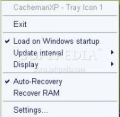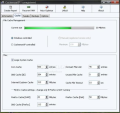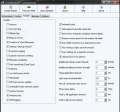You may never think you need to keep an eye on your PC`s performance. That's the way I used to think too a long time ago - I thought that once my PC was bought and brought home I didn't have to care about anything else. It will just work, without any flaws, forever and ever.
But you probably know, as I know for sure now, that this isn't true. Well, that's why one day I had to start looking for programs that could tell me which of my computer's components is not working well enough and maybe even solve some of these issues.
Among other programs, I also tried CachemanXP. At that time, I had to try an older version of this program, but I was also able to take a good look at the present version of CachemanXP.
Just after I installed it and started it I was a bit surprised to discover CachemanXP 1.5 hadn't already begun scanning my system, giving me hints about what had to be fixed, or showing me a fancy or complicated interface. It just went in the system tray and showed me two small icons. One displaying the number of megabytes of free RAM and the other one displaying a tiny graphic for the CPU Usage. Left clicking on the second icon would change the graphical view of the CPU usage into numerical view.
Right clicking on any of the two icons would just show up a small menu offering choices like exiting the program and choosing the update interval - which is set between 1 and 10 seconds, but in my humble opinion having a refresh interval slightly bigger than 10 seconds could have been a good choice. From this menu you may also check or uncheck the loading on Windows startup and choose the display type of the tray icons - numerical, graphical or block and whose performance would be shown in those icons - RAM usage, free RAM, paging file usage, CPU usage or CPU idle time. In this menu, there are also other options: check or uncheck auto-recovery, directly request RAM recovery and display the settings.
Well, this last part is the interesting one. Once you clicked the settings, you entered the part where you may finally see some interface and some menus, quite well structured, yet not too colorful or fancy. Quite a Spartan look for a program that is not meant to be good-looking, but rather functional.
The first thing you may want to do once you have entered the settings is to request a report. Clicking the "Create Report" part of this menu won't do anything else but create a text file containing data about your system at the time you clicked this option. After all, this is what a report should look like. Actually, this report is a view of what CachemanXP is displaying in the information tab in the settings, plus some basic information about your PC, like the OS you use, the CPU type or the display adapter.
In the upper menu, besides the "Create Report" tab you will also find a "Recover RAM" tab and the "Auto-Optimize" tab. Clicking the Recover RAM tab will do what its name says - recover RAM. No other menu displayed or anything like that. The Auto-Optimize can be used only in the full registered version.
In the middle section, you may find five other menu tabs, this time much more important than those you may have found in the upper section. The "Information" tab displays the CPU and RAM usage, but also a table with the programs running on your system at the moment. This table looks quite similar to what you may see in the Windows XP Task Manager - the Processes tab, with the big difference that in CachemanXP you may also see the path of those running programs. Right click any of them and you can choose to end, kill, or lower the RAM usage for that program. The other four tabs beside the "Information" tab are: the one taking care of cache file management, from where you may choose if the current size suits your need, the tweaks-tab, the backup and the options-tab.
Any setting altered in the tweaks menu and the program will ask for a system reboot. But you may still select to reboot later.
Having the settings-window of CachemanXP opened will ask for about two times more RAM usage than having CachemanXP silently hidden in the tray; still, the RAM usage in both situations is low enough to deserve a standing ovation. Well, at least lower than Windows Explorer.
The support is quite a well-done matter, including a FAQ part in the help section. Even though the graphical part of this program is quite simple, it is well-structured and easy-to-use. Uninstalling this application is done with no problems, in a quick and easy way.
Well, in the end, maybe this program would have been much more suitable for everyone's needs if it could handle more issues - like registry issues or the programs running at startup. Otherwise, it could be frequently taken and used only as a RAM-recovery tool. Anyway, a well-done one. Its price looks quite well chosen and realistic, but not necessarily attractive.
The Good
CachemanXP is easy to use, easy to understand and easy to be tolerated.
The Bad
Fails to truly impress and is offering pretty much what any other product of the same type offers. Nothing new, nothing thrilling. And it won't work on Windows Vista. Not yet.
The Truth
Whenever you need a small simple program to watch over your system and do a few optimizations - you may count on it. I guess it will suit the needs of all those who just want something simple and with quite enough efficiency. If you want a bigger, more complex, sophisticated or even more colorful program - you'd better think again.
Check out the pictures below.
 14 DAY TRIAL //
14 DAY TRIAL // 







